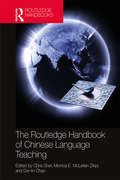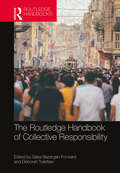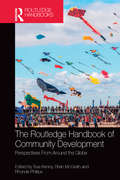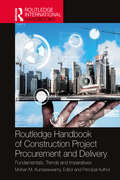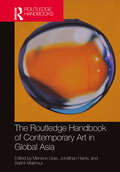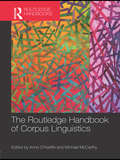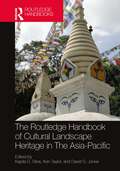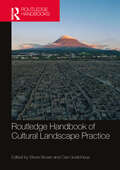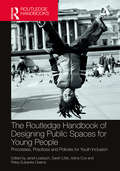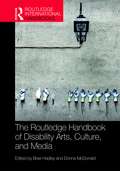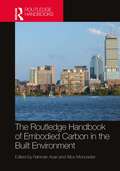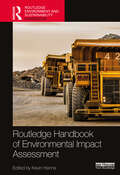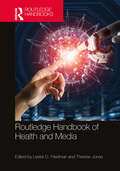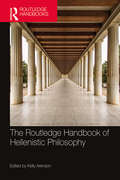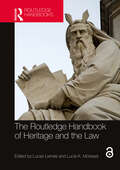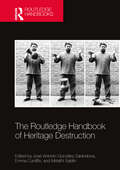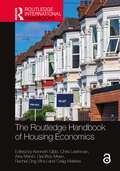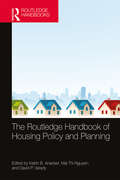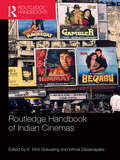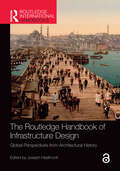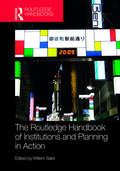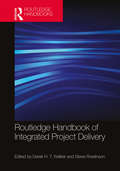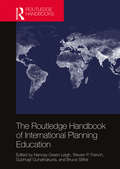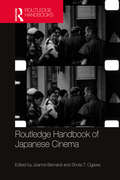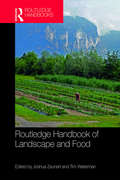- Table View
- List View
The Routledge Handbook of Chinese Language Teaching
by Chris Shei Monica E McLellan Zikpi Der-Lin ChaoThe Routledge Handbook of Chinese Language Teaching defines Chinese language teaching in a pedagogical, historical, and contemporary context. Throughout the volume, teaching methods are discussed, including the traditional China-based approach, and Western methods such as communicative teaching and the immersion program. The Handbook also presents a pedagogical model covering pronunciation, tones, characters, vocabulary, grammar, and the teaching of listening, speaking, reading, and writing. The remaining chapters explore topics of language assessment, technology enhanced instruction, teaching materials and resources, Chinese for specific purposes, classroom implementation, social contexts of language teaching and language teaching policies, and pragmatics and culture. Ideal for scholars and researchers of Chinese language teaching, the Handbook will benefit educators and teacher training programs. This is the first comprehensive volume exploring the growing area of Chinese language pedagogy.
The Routledge Handbook of Collective Responsibility (Routledge Handbooks in Philosophy)
by Bazargan-Forward, Saba / Tollefsen, DeborahThe Routledge Handbook of Collective Responsibility comprehensively addresses questions about who is responsible and how blame or praise should be attributed when human agents act together. Such questions include: Do individuals share responsibility for the outcome or are individuals responsible only for their contribution to the act? Are individuals responsible for actions done by their group even when they don’t contribute to the outcome? Can a corporation or institution be held morally responsible apart from the responsibility of its members? The Handbook’s 35 chapters—all appearing here for the first time and written by an international team of experts—are organized into four parts:Part I: Foundations of Collective ResponsibilityPart II: Theoretical Issues in Collective ResponsibilityPart III: Domains of Collective ResponsibilityPart IV: Applied Issues in Collective ResponsibilityEach part begins with a short introduction that provides an overview of issues and debates within that area and a brief summary of its chapters. In addition, a comprehensive index allows readers to better navigate the entirety of the volume’s contents. The result is the first major work in the field that serves as an instructional aid for those in advanced undergraduate courses and graduate seminars, as well as a reference for scholars interested in learning more about collective responsibility.
The Routledge Handbook of Community Development: Perspectives from Around the Globe
by Rhonda Phillips Sue Kenny Brian McGrathThe Routledge Handbook of Community Development explores community development theory and practice across the world. The book provides perspectives about community development as an interactive, relevant and sometimes contradictory way to address issues impacting the human condition. It promotes better understanding of the complexities and challenges in identifying, designing, implementing and evaluating community development constructs, applications and interventions. This edited volume discusses how community development is conceptualized as an approach, method or profession. Themes provide the scope of the book, with projects, issues or perspectives presented in each of these areas. This handbook provides invaluable contextualized insights on the theory and practice of community development around core themes relevant in society. Each chapter explores and presents an issue, perspectives, project or case in the thematic areas, with regional and country context included. It is a must-read for students and researchers working in community development, planning and human geography and an essential reference for any professional engaged in community development.
Routledge Handbook of Construction Project Procurement and Delivery: Fundamentals, Trends and Imperatives
by Mohan M. KumaraswamyThis Handbook provides the knowledge needed to design and deploy proactive construction project procurement and delivery systems based on essentials while addressing emerging construction industry imperatives in order to boost overall performance.Section 1 of the Handbook provides an overview, while Section 2 provides the fundamentals with fresh insights into the building blocks and trends in performance-linked procurement and delivery, including procurement strategies and commercial priorities, project briefs and management plans, design management, stakeholder management, risk management, ethics and professionalism, team building, information and knowledge management, digital aids, conflict, claims and dispute management, collaborative contracting, relationship-based teamworking and linking to built asset management.Section 3 explores and expands on specific trends, including sub-contractor selection, Building Information Modelling (BIM) in project cost management; off-site and modern methods of construction; 4IR/5IR technologies; and constructing for the circular economy, supply chain resilience and social value imperatives in this domain.While other books describe standard processes or focus on specific strategies such as design and build, target cost contracting or integrated project delivery, this Handbook presents the fundamentals of such processes and protocols together with invited specialist insights into growing trends and imperatives in holistic procurement and delivery. Those who could benefit from this Handbook include academics, researchers, postgraduate students, policy makers and administrators, managers in both public and private sectors involved with planning and overseeing construction project procurement and/or delivery and undergraduates looking for a balanced introduction and useful insights into what is critical to the success of construction projects, organisations and the industry itself.
The Routledge Handbook of Contemporary Art in Global Asia
by Menene Gras Jonathan Harris Bashir MakhoulThis substantial collection of newly commissioned essays presents an ambitious, entertaining, and accessible guide to developments in Asian art over the past 20 years of the epoch of globalization. The term ‘global Asia’ signals the genesis and evolution of contemporary art within the context of global economic, social, political, and intellectual change related to the end of the Cold War, decolonization, the emergence of postcolonial societies and cultures, and the rise of a global contemporary art world. In the handbook its editors establish, in an extended introductory section and in four section introductions, the theoretical, geographical, and historical parameters within which the contemporary visual arts of ‘global Asia’ may be described, analyzed, and evaluated. The collected chapters provide a diverse, multiauthored, heterogeneous, and genuinely plural account of art and its contexts. The democratic and inclusive character of globalization is reflected and produced within this anthology, which includes different styles of writing as well as varieties of analytic and thematic focus. The anthology will appeal to both scholars and students in art history, art practice, curation, contemporary art, fine art, cultural studies, and globalization studies.
The Routledge Handbook of Corpus Linguistics (Routledge Handbooks in Applied Linguistics)
by Anne O’KeeffeThe Routledge Handbook of Corpus Linguistics provides a timely overview of a dynamic and rapidly growing area with a widely applied methodology. Through the electronic analysis of large bodies of text, corpus linguistics demonstrates and supports linguistic statements and assumptions. In recent years it has seen an ever-widening application in a variety of fields: computational linguistics, discourse analysis, forensic linguistics, pragmatics and translation studies. Bringing together experts in the key areas of development and change, the handbook is structured around six themes which take the reader through building and designing a corpus to using a corpus to study literature and translation. A comprehensive introduction covers the historical development of the field and its growing influence and application in other areas. Structured around five headings for ease of reference, each contribution includes further reading sections with three to five key texts highlighted and annotated to facilitate further exploration of the topics. The Routledge Handbook of Corpus Linguistics is the ideal resource for advanced undergraduates and postgraduates.
The Routledge Handbook of Cultural Landscape Heritage in The Asia-Pacific (Routledge Handbooks on Museums, Galleries and Heritage)
by Ken Taylor David S. Jones Kapila D. SilvaThe Routledge Handbook of Cultural Landscape Heritage in the Asia-Pacific revisits the use, growth, and potential of the cultural landscape methodology in the conservation and management of culture-nature heritage in the Asia-Pacific region. Taking both a retrospective and prospective view of the management of cultural heritage in the region, this volume argues that the plurality and complexity of heritage in the region cannot be comprehensively understood and effectively managed without a broader conceptual framework like the cultural landscape approach. The book also demonstrates that such an approach facilitates the development of a flexible strategy for heritage conservation. Acknowledging the effects of rapid socio-economic development, globalization, and climate change, contributors examine the pressure these issues place on the sustenance of cultural heritage. Including chapters from more than 20 countries across the Asia-Pacific region, the volume reviews the effectiveness of theoretical and practical potentials afforded by the cultural landscape approach and examines how they have been utilized in the Asia-Pacific context for the last three decades. The Routledge Handbook of Cultural Landscape Heritage in the Asia-Pacific provides a comprehensive analysis of the processes of cultural landscape heritage conservation and management. As a result, it will be of interest to academics, students, and professionals who are based in the fields of cultural heritage management, architecture, urban planning, landscape architecture, and landscape management.
Routledge Handbook of Cultural Landscape Practice (Routledge International Handbooks)
by Steve Brown Cari GoetcheusCultural landscapes, which in the field of heritage studies and practice relates to caring for and safeguarding heritage landscapes, is a concept embedded in contemporary conservation. Heritage conservation has shifted from an historical focus on buildings, city centres, and archaeological sites to encompass progressively more diverse forms of heritage and increasingly larger geographic areas, embracing both rural and urban landscapes. While the origin of the idea of cultural landscapes can be traced to the late-19th century Euro-American scholarship, it came to global attention after 1992 following its adoption as a category of ‘site’ by the UNESCO World Heritage Committee. Today, cultural landscape practice has become increasingly complex given the expansion of the values and meanings of heritage, the influence of environmental challenges such as human induced climate change, technological advancements, and the need to better understand and interpret human connections to place and landscapes. The aim of this handbook is to strike a balance between theory and practice, which we see as inseparable, while also seeking to achieve a geographical spread, disciplinary diversity and perspectives, and a mix of authors from academic, practitioner, management, and community backgrounds.
The Routledge Handbook of Designing Public Spaces for Young People: Processes, Practices and Policies for Youth Inclusion
by Janet Loebach Sarah Little Adina Cox Patsy Eubanks OwensThe Routledge Handbook of Designing Public Spaces for Young People is a thorough and practical resource for all who wish to influence policy and design decisions in order to increase young people’s access to and use of public spaces, as well as their role in design and decision-making processes. The ability of youth to freely enjoy public spaces, and to develop a sense of belonging and attachment to these environments, is critical for their physical, social, cognitive, and emotional development. Young people represent a vital citizen group with legitimate rights to occupy and shape their public environments, yet they are often driven out of public places by adult users, restrictive bylaws, or hostile designs. It is also important that children and youth have the opportunity to genuinely participate in the planning of public spaces, and to have their needs considered in the design of the public realm. This book provides both evidence and tools to help effectively advocate for more youth-inclusive public environments, as well as integrate youth directly into both research and design processes related to the public realm. It is essential reading for researchers, design and planning professionals, community leaders, and youth advocates.
The Routledge Handbook of Disability Arts, Culture, and Media
by Bree Hadley Donna McDonaldIn the last 30 years, a distinctive intersection between disability studies – including disability rights advocacy, disability rights activism, and disability law – and disability arts, culture, and media studies has developed. The two fields have worked in tandem to offer critique of representations of disability in dominant cultural systems, institutions, discourses, and architecture, and develop provocative new representations of what it means to be disabled. Divided into 5 sections: Disability, Identity, and Representation Inclusion, Wellbeing, and Whole-of-life Experience Access, Artistry, and Audiences Practices, Politics and the Public Sphere Activism, Adaptation, and Alternative Futures this handbook brings disability arts, disability culture, and disability media studies – traditionally treated separately in publications in the field to date – together for the first time. It provides scholars, graduate students, upper level undergraduate students, and others interested in the disability rights agenda with a broad-based, practical and accessible introduction to key debates in the field of disability art, culture, and media studies. An internationally recognised selection of authors from around the world come together to articulate the theories, issues, interests, and practices that have come to define the field. Most critically, this book includes commentaries that forecast the pressing present and future concerns for the field as scholars, advocates, activists, and artists work to make a more inclusive society a reality.
The Routledge Handbook of Embodied Carbon in the Built Environment
by Rahman Azari Alice MoncasterThis handbook explores the critically important topic of embodied carbon, providing advanced insights that focus on measuring and reducing embodied carbon from across the built environment, including buildings, urban areas and cities, and construction materials and components. Split into five distinct sections, international experts, researchers, and professionals present the recent developments in the field of embodied carbon from various perspectives and at different scales of material, building, and city. Following an introduction to the embodied carbon question, the chapters in Section 1 then cover the key debates around issues such as the politics of embodied carbon, links between embodied carbon and thermal mass, and the misuse of carbon offsets. Section 2 reviews the embodied carbon policies in a selected number of countries. Sections 3, 4, and 5 approach the topic of embodied carbon from urban-, building-, and material-scale perspectives, respectively, and use case studies to demonstrate estimation techniques and present opportunities and challenges in embodied carbon mitigation. This will be important reading for upper-level students and researchers in Architecture, Urban Planning, Engineering, and Construction disciplines. Presenting case studies of embodied carbon assessment, this book will also help practicing architects, engineers, and urban planners understand embodied carbon estimation techniques and different mitigation strategies.
Routledge Handbook of Environmental Impact Assessment (Routledge Environment and Sustainability Handbooks)
by Kevin HannaGlobally, environmental impact assessment (EIA) is one of the most enduring and influential environmental management tools. This handbook provides readers with a strong foundation for understanding the practice of EIA, by outlining the different types of assessment while also providing a guide to best practice. This collection deploys a research and practice-based approach to the subject, delivering an overview of EIA as an essential and practical tool of environmental protection, planning, and policy. To best understand the most pertinent issues and challenges surrounding EIA today, this volume draws together prominent researchers, practitioners, and young scholars who share their work and knowledge to cover two key parts. The first part introduces EIA processes and best practices through analytical and critical chapters on the stages/elements of the EIA process and different components and forms of assessment. These provide examples that cover a wide range of assessment methods and cross-cutting issues, including cumulative effects assessment, social impact assessment, Indigenous-led assessment, risk assessment, climate change, and gender-based assessment. The second part provides jurisdictional reviews of the European Union, the US National Environmental Policy Act, recent assessment reforms in Canada, EIA in developing economies, and the EIA context in England. By providing a concise outline of the process followed by in-depth illustrations of approaches, methods and tools, and case studies, this book will be essential for students, scholars, and practitioners of environmental impact assessment.
Routledge Handbook of Health and Media
by Lester D. Friedman Therese JonesThe Routledge Handbook of Health and Media provides an extensive review and exploration of the myriad ways that health and media function as a symbiotic partnership that profoundly influences contemporary societies. A unique and significant volume in an expanding pedagogical field, this diverse collection of international, original, and interdisciplinary essays goes beyond issues of representation to engage in scholarly conversations about the web of networks that inextricably bind media and health to each other. Divided into sections on film, television, animation, photography, comics, advertising, social media, and print journalism, each chapter begins with a concrete text or texts, using it to raise more general and more theoretical issues about the medium in question. As such, this Handbook defines, expands, and illuminates the role that the humanities and arts play in the education and practice of healthcare professionals and in our understanding of health, illness, and disability. The Routledge Handbook of Health and Media is an invaluable reference for academics, students and health professionals engaged with cultural issues in media and medicine, popular representations of disease and disability, and the patient/professional health care encounter.
The Routledge Handbook of Hellenistic Philosophy (Routledge Handbooks in Philosophy)
by Kelly ArensonHellenistic philosophy concerns the thought of the Epicureans, Stoics, and Skeptics, the most influential philosophical groups in the era between the death of Alexander the Great (323 BCE) and the defeat of the last Greek stronghold in the ancient world (31 BCE). The Routledge Handbook of Hellenistic Philosophy provides accessible yet rigorous introductions to the theories of knowledge, ethics, and physics belonging to each of the three schools, explores the fascinating ways in which interschool rivalries shaped the philosophies of the era, and offers unique insight into the relevance of Hellenistic views to issues today, such as environmental ethics, consumerism, and bioethics. Eleven countries are represented among the Handbook’s 35 authors, whose chapters were written specifically for this volume and are organized thematically into six sections: The people, history, and methods of Epicureanism, Stoicism, and Skepticism. Earlier philosophical influences on Hellenistic thought, such as Aristotle, Socrates, and Presocratics. The soul, perception, and knowledge. God, fate, and the primary principles of nature and the universe. Ethics, political theory, society, and community. Hellenistic philosophy’s relevance to contemporary life. Spanning from the ancient past to the present, this Handbook aims to show that Hellenistic philosophy has much to offer all thinking people of the twenty-first century.
The Routledge Handbook of Heritage and the Law (Routledge Handbooks on Museums, Galleries and Heritage)
by Lucas Lixinski Lucie K. MorissetThe Routledge Handbook of Heritage and the Law sheds light on the relationship between the two fields and analyses how the law shapes heritage and heritage practice in both expected and unexpected ways.Including contributions from 41 authors working across a range of jurisdictions, the volume analyses the law as a transnational phenomenon and uses international and comparative legal methodologies to distil lessons for broad application. Demonstrating that the law is fundamentally a language of power and contestation, the Handbook shows how this impacts our views of heritage. It also shows that, to understand the ways in which the law impacts key aspects of heritage practice, it is important to tap into the possibilities of heritage as points of convergence of identity, struggles over resources, and the distribution of power. Framing heritage as a driver for legal engagement rather than a passive regulatory object, the book first reviews the legal fields or mechanisms that can shape action in the heritage field, then questions how these enable authority and give power to those who seize heritage, and finally envisions how the discussion between heritage and the law can lay new grounds in both those fields. Lifting the mists that often render the law opaque in heritage studies, the Handbook showcases the law as a medium through which the culture and the power of heritage are expressed and might be shared.The Routledge Handbook of Heritage and the Law presents a view of the law that is aimed at those who wish to reflect on how law has changed, or could change, what heritage is and how it can support social, cultural, local, or other development. It will be of interest to scholars, students, policymakers, and practitioners working in the areas of museum studies, heritage studies, and urban studies, as well as in cultural intervention and planning.
The Routledge Handbook of Heritage Destruction (Routledge Handbooks on Museums, Galleries and Heritage)
by Zarandona, José Antonio González Emma Cunliffe Melathi SaldinThe Routledge Handbook of Heritage Destruction presents a comprehensive view on the destruction of cultural heritage and offers insights into this multifaceted, interdisciplinary phenomenon; the methods scholars have used to study it; and the results these various methods have produced. By juxtaposing theoretical and legal frameworks and conceptual contexts alongside a wide distribution of geographical and temporal case studies, this book throws light upon the risks, and the realizations, of art and heritage destruction. Exploring the variety of forces that drive the destruction of heritage, the volume also contains contributions that consider what forms heritage destruction takes and in which contexts and circumstances it manifests. Contributors, including local scholars, also consider how these drivers and contexts change, and what effect this has on heritage destruction, and how we conceptualise it. Overall, the book establishes the importance of the need to study the destruction of art and cultural heritage within a wider framework that encompasses not only theory but also legal, military, social, and ontological issues. The Routledge Handbook of Heritage Destruction will contribute to the development of a more complete understanding and analysis of heritage destruction. The Handbook will be useful to academics, students, and professionals with interest in heritage, conservation and preservation, history and art history, archaeology, anthropology, philosophy, and law.
The Routledge Handbook of Housing Economics (Routledge International Handbooks)
by Kenneth Gibb Chris Leishman Alex Marsh Geoffrey Meen Rachel Ong ViforJ Craig WatkinsThe Routledge Handbook of Housing Economics brings together an international panel of contributors to present a comprehensive overview of this important field within economics. Housing occupies an increasingly central role in modern society, dominating consumer assets and spending, forming an important part of social policy and being a large enough market to impact the macroeconomy. This handbook tackles these themes, along with other critical issues such as intergenerational housing inequality and the efficiency and social justice of housing interventions.This volume is structured in four main parts. It starts with eight chapters in microeconomics and housing. This is followed by two shorter sections on macroeconomics and finance. The final main part of the book is concerned with eight chapters on policy dimensions. While many of the chapters are rooted in mainstream economics and finance applied to housing, there are also chapters stressing institutional, behavioural and political economy orientations, as well as those that explicitly challenge more mainstream accounts. The contributing authors are based in Europe, North America and Australia and all draw in international literature to provide state of the art reviews of their topics.This carefully curated handbook will be essential reading for advanced students, researchers and policy makers in housing economics, urban economics, urban planning, public economics and real estate economics and finance.
The Routledge Handbook of Housing Policy and Planning
by Katrin B. Anacker Mai Thi Nguyen David P. VaradyThe Routledge Handbook of Housing Policy and Planning provides a comprehensive multidisciplinary overview of contemporary trends in housing studies, housing policies, planning for housing, and housing innovations in the United States, the United Kingdom, and Continental Europe. In 29 chapters, international scholars discuss aspects pertaining to the right to housing, inequality, homeownership, rental housing, social housing, senior housing, gentrification, cities and suburbs, and the future of housing policies. This book is essential reading for students, policy analysts, policymakers, practitioners, and activists, as well as others interested in housing policy and planning.
Routledge Handbook of Indian Cinemas
by Wimal Dissanayake K. Moti GokulsingIndia is the largest film producing country in the world and its output has a global reach. After years of marginalisation by academics in the Western world, Indian cinemas have moved from the periphery to the centre of the world cinema in a comparatively short space of time. Bringing together contributions from leading scholars in the field, this Handbook looks at the complex reasons for this remarkable journey. Combining a historical and thematic approach, the Handbook discusses how Indian cinemas need to be understood in their historical unfolding as well as their complex relationships to social, economic, cultural, political, ideological, aesthetic, technical and institutional discourses. The thematic section provides an up-to-date critical narrative on diverse topics such as audience, censorship, film distribution, film industry, diaspora, sexuality, film music and nationalism. The Handbook provides a comprehensive and cutting edge survey of Indian cinemas, discussing Popular, Parallel/New Wave and Regional cinemas as well as the spectacular rise of Bollywood. It is an invaluable resource for students and academics of South Asian Studies, Film Studies and Cultural Studies.
The Routledge Handbook of Infrastructure Design: Global Perspectives from Architectural History
by Joseph HeathcottThe Routledge Handbook of Infrastructure Design explores the multifaceted nature of infrastructure through the global lens of architectural history. Infrastructure holds the world together. Yet even as it connects some people, it divides others, sorting access and connectivity through varied social categories such as class, race, gender, and citizenship. This collection examines themes across broad spans of time, raises questions of linkage and scale, investigates infrastructure as phenomenon and affect, and traces the interrelation of aesthetics, technology, and power. With a diverse range of contributions from 33 scholars, this volume presents new research from regions including South and East Asia, Sub-Saharan Africa, South America, North America, Western Europe, the Middle East, and the former Soviet Union. This extraordinary group of authors bring close attention to the materials, functions, and aesthetics of infrastructure systems as these unfold within their cultural and political contexts. They provide not only new knowledge of specific artifacts, such as the Valens Aqueduct, the Hong Kong waterfront, and the Pan-American Highway, but also new ways of conceptualizing, studying, and understanding infrastructure as a worlding process. The Routledge Handbook of Infrastructure Design provides richly textured, thoroughly evidenced, and imaginatively drawn arguments that deepen our understanding of the role of infrastructure in creating the world in which we live. It is a must-read for academics and students.
The Routledge Handbook of Institutions and Planning in Action
by Willem SaletThe Routledge Handbook of Institutions and Planning in Action contains a selection of 25 chapters prepared by specialized international scholars of urban planning and urban studies focusing on the question of how institutional innovation occurs in practices of action. The contributors share expertise on institutional innovation and philosophical pragmatism. They discuss the different facets of these two conceptual frameworks and explore the alternative combinations through which they can be approached. The relevance of these conceptual lines of thought will be exemplified in exploring the contemporary practices of sustainable (climate-proof) urban transition. The aim of the handbook is to give a boost to the turn of institutional analysis in the context of action in changing cities. Both philosophical pragmatism and institutional innovation rest on wide international uses in social sciences and planning studies, and may be considered as complementary for many reasons. However, the combination of these different approaches is all but evident and creates a number of dilemmas. After an encompassing introductory section entitled Institutions in Action, the handbook is further divided into the following sections: Institutional innovation Pragmatism: The Dimension of Action On Justification Cultural and Political Institutions in Action Institutions and Urban Transition
Routledge Handbook of Integrated Project Delivery
by Derek Walker Steve RowlinsonThe concept of integrated project delivery (IPD) has evolved as a result of the need for highly expert teams of people to collaborate to deliver extremely complex projects, to manage expectations about delivery speed, changes in governance standards and to take advantage of and manage expectations raised by rapid advances in technology. All this demands effective change management. This is the first Handbook to contextualise and thematically explore the concept with an emphasis on rigorous practical and theoretical validation. The Handbook is divided into five sections, each with a focus on several interconnected themes including: An introduction to IPD concepts. The foundational elements and characteristics of IPD. People, culture and collaboration as key ingredients to successful and effective IPD. Technology and process aspects of relational contracting forms such as IPD. New and relevant perspectives to IPD that have received scant attention to date. Aspects and emerging issues that are rarely consciously considered in traditional project delivery due to the commercial imperative that drives firms and client organisations. The Handbook offers both discussions of these key themes, and also in-depth research into construction and other industry project procurement and delivery that spans decades. In addition, the Handbook presents ‘best’ and ‘better’ practice, but also includes insights into cutting-edge experimental developments in technology and practices where proof of concept is currently being developed into emerging practice. Contributing authors in this Handbook collaborate with the co-editors to draw together an integrated set of chapters that align to deliver a coherent narrative of the IPD concept. It is an invaluable reference for practitioners and academics alike, and useful as core course content for numerous degree programs of study and professional development courses.
The Routledge Handbook of International Planning Education
by Nancey Green Leigh Steven P. French Subhrajit Guhathakurta Bruce StiftelThe Routledge Handbook of International Planning Education is the first comprehensive handbook with a unique focus on planning education. Comparing approaches to the delivery of planning education by three major planning education accreditation bodies in the United States, Australia, and the United Kingdom, and reflecting concerns from other national planning systems, this handbook will help to meet the strong interest and need for understanding how planning education is developed and delivered in different international contexts. The handbook is divided into five major sections, including coverage of general planning knowledge, planning skills, traditional and emerging planning specializations, and pedagogy. An international cohort of contributors covers each subject’s role in educating planners, its theory and methods, key literature contributions, and course design. Higher education’s response to globalization has included growth in planning educational exchanges across international boundaries; The Routledge Handbook of International Planning Education is an essential resource for planners and planning educators, informing the dialogue on the mobility of planners educated under different national schema.
Routledge Handbook of Japanese Cinema
by Joanne Bernardi Shota T. OgawaThe Routledge Handbook of Japanese Cinema provides a timely and expansive overview of Japanese cinema today, through cutting-edge scholarship that reflects the hybridity of approaches defining the field. The volume’s twenty-one chapters represent work by authors with diverse backgrounds and expertise, recasting traditional questions of authorship, genre, and industry in broad conceptual frameworks such as gender, media theory, archive studies, and neoliberalism. The volume is divided into four parts, each representing an emergent area of inquiry: "Decentring Classical Cinema" "Questions of Industry" "Intermedia as an Approach" "The Object Life of Film" This is the first anthology of Japanese cinema scholarship to span the temporal framework of 200 years, from the vibrant magic lantern culture of the nineteenth century, through to the formation of the film industry in the twentieth century, and culminating in cinema’s migration to gaming, surveillance video, and other new media platforms of the twenty-first century. This handbook will prove a useful resource to students and scholars of Japanese studies, film studies, and cultural studies more broadly.
Routledge Handbook of Landscape and Food
by Joshua Zeunert Tim WatermanSince the turn of the millennium, there has been a burgeoning interest in, and literature of, both landscape studies and food studies. Landscape describes places as relationships and processes. Landscapes create people’s identities and guide their actions and their preferences, while at the same time are shaped by the actions and forces of people. Food, as currency, medium, and sustenance, is a fundamental part of those landscape relationships. This volume brings together over fifty contributors from around the world in forty profoundly interdisciplinary chapters. Chapter authors represent an astonishing range of disciplines, from agronomy, anthropology, archaeology, conservation, countryside management, cultural studies, ecology, ethics, geography, heritage studies, landscape architecture, landscape management and planning, literature, urban design and architecture. Both food studies and landscape studies defy comprehension from the perspective of a single discipline, and thus such a range is both necessary and enriching. The Routledge Handbook of Landscape and Food is intended as a first port of call for scholars and researchers seeking to undertake new work at the many intersections of landscape and food. Each chapter provides an authoritative overview, a broad range of pertinent readings and references, and seeks to identify areas where new research is needed—though these may also be identified in the many fertile areas in which subjects and chapters overlap within the book.
